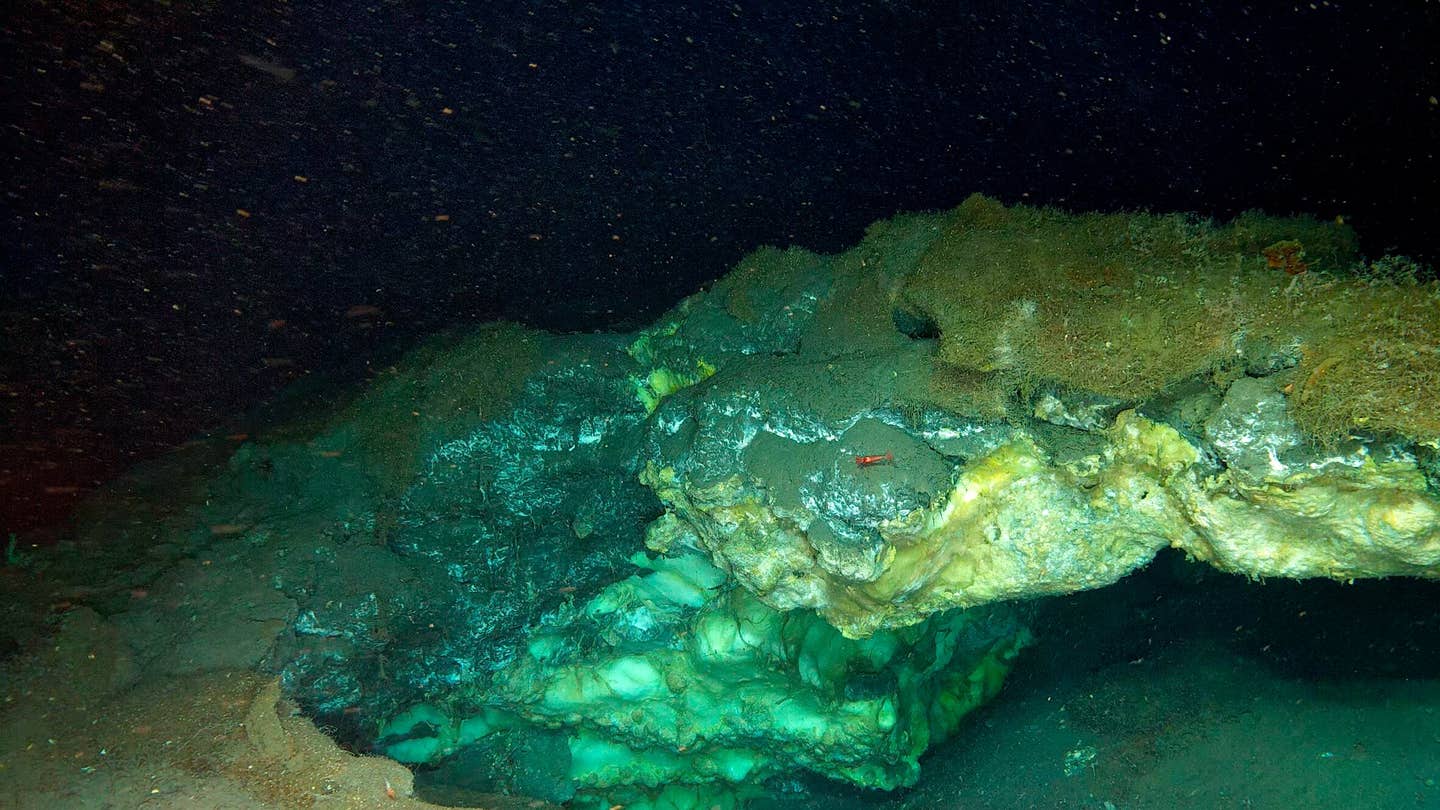Earth’s magnetic field flipped wildly 565 million years ago and life changed forever
Ancient Moroccan rocks reveal how Earth’s magnetic field flipped wildly 565 million years ago, reshaping life’s early history.

 Edited By: Joshua Shavit
Edited By: Joshua Shavit

David Evans, left, and James Pierce in the Yale Paleomagnetic Laboratory. (CREDIT: Allie Barton)
Long before life thrived in Earth’s oceans, the planet’s magnetic field became disorganized. Deep within the ancient rocks of Morocco, scientists have recovered one of the clearest records of that restless period, a time that predates life on Earth, over half a billion years ago, when the planet’s invisible shield twisted, flipped, and staggered like a compass gone mad.
Within the dry ridges of the Anti-Atlas Mountains, volcanic and sedimentary layers reveal a story of a world on the verge of change. The same rocks, hardened from lava that once spread over a prehistoric landscape, have retained the magnetic whisper of an unstable planet. When the molten lava cooled, the iron within the rock became aligned with the magnetic field of the planet at the time, freezing the magnetic direction of the poles in the rocks.
Researchers from Yale University, in collaboration with multiple international institutions, used the ancient rocks to reconstruct what Earth’s magnetic field was doing near the end of the Ediacaran Period, around 568-562 million years ago. By integrating high-precision radioactive dating and developing statistical models, the study showed that Earth’s magnetic field was not steady and calm; rather, it was changing rapidly, and at different times over thousands of years.
Reading the Magnetic Past
In order to construct their magnetic record, scientists studied four well-located sites in the Bou Azzer region of Morocco. Each site contained unique layers of volcanic ash and lava; all of them originated from the Ouarzazate Group. The layers acted as markers in time, which linked the four sites together.
By doing so, the authors of the study were able to measure the changes in magnetic direction hundreds of meters apart within the same volcanic sequence of rock. Zircon crystals buried in the ancient ash contained tiny atomic clocks that dated the rocks based on uranium-lead dating. These crystals gave anchor points of 568, 567, and 562 million years ago, leading them to have a precise hold on how the magnetic field changed over time.
Next came the data modeling, a comprehensive computational approach using a Bayesian age-depth model that entailed millions of iterations. Finally, it allowed scientists to make estimates of how fast those changes were taking place, ultimately converting the signature of the magnetic field into a dynamic timeline.
A Moving Planet
The results showed that these poles were moving at remarkable rates—up to seven degrees per million years, which was much faster than the generally accepted slow plate tectonic movements of continents. If these movements were due to landmasses moving, one cannot reasonably explain these rapid movements. Rather, this evidence indicates that the magnetic field itself was wildly unstable.
"Prior studies typically considered the field behaved like today," said Yale geologist David Evans "we found structure in variability, not chaos." Ultimately, Evans data model showed that there were varying structures in the data and not just disorder. That is, the variations were made up of bursts of instability, followed by relative stability.
It likely ruled out older theories that assumed the entire crust and mantle of the planet tilted as a result of what scientists refer to as true polar wander. Instead of major changes to the planet, the evidence suggested the poles were moving at a much more erratic pace. PhD student James Pierce illustrated that by sampling at a very high resolution, the team was able to observe the poles oscillating too-and-fro over time, almost as if the magnetic field could not determine which direction to point to.
Life Under an Unsteady Sky
The late Ediacaran was a time of upheaval. Glaciers were retreating, oceans were changing, and the first large, complex organisms were spreading across the seafloor. But during this time, the magnetic field, which protects the Earth from solar radiation, weakened to nearly one-tenth of its usual strength. A weaker magnetic field means increased cosmic radiation striking Earth’s surface, possibly influencing climate and evolution.
If you had stood on those shores, the sky might have been glowing with auroras that occurred with regular frequency. Radiation levels may have been higher and changed the chemistry of the atmosphere. Such shifts may have also triggered the biological leap that followed, the Cambrian explosion of diverse life.
For scientists, the connection between processes happening deep within the Earth and the emergence of life is a wonderful and humbling reminder of how intimately connected everything on this planet can be. “My whole career has been about mapping the motions of continents and oceans through time,” Evans said, “The Ediacaran is the period that has been holding this back because the magnetic data doesn’t make any sense. Now we can finally make the connection with new tools.”
Mapping a Better Map of the Ancient Earth
The research also opens a new avenue for geologists. Researchers used improved statistical treatments for volcanic and sedimentary rocks to provide a framework for reconstructing the positioning of continents hundreds of millions of years ago. Their tools allowed for the reconstruction of north-south and east-west motions of land masses to occur, a breakthrough for deep-time mapping.
Now, by comparing the record of Morocco with other ancient records, scientists can show how the West African region used to connect with North America and a few other continental land masses in its past. The reconstructions help to refine the models of how the molten core, mantle, and crust interact to generate a magnetic field. The reversals happen much faster than would have been anticipated, suggesting that the internal engine of the Earth is a lot more dynamic than previously considered.
Even today, it is noted by satellites that the field is slowly weakening and the poles are drifting toward Siberia and the South Atlantic. The Moroccan rocks remind us that the magnetic field has collapsed, and rebuilt, and life continued.
Practical Implications of the Research
Better yet, this work helps scientists to understand how Earth’s magnetic field functions over vast amounts of time. It gives modern-day researchers a frame of reference for predicting how the field may change in the future, and what it will mean for satellites, navigation, and even possibly sustaining electrical grids.
In a broader context, the study connects rhythms of the Earth’s internal workings to life’s story, and hints about life’s evolution influenced by magnetic instability.
For scientists, it reinforces the message that Earth’s magnetic protective shield acts resiliently, but also is not constant, and by understanding its history, we may also understand how to protect our technological future.
Research findings are available online in the journal Science Advances.
Related Stories
- Earth’s magnetic field is shifting — and satellites are feeling it
- The Moon once had magnetic fields as strong as Earth’s
- How does the Earth generate its magnetic field?
Like these kind of feel good stories? Get The Brighter Side of News' newsletter.
Joseph Shavit
Science News Writer, Editor-At-Large and Publisher
Joseph Shavit, based in Los Angeles, is a seasoned science journalist, editor and co-founder of The Brighter Side of News, where he transforms complex discoveries into clear, engaging stories for general readers. With experience at major media groups like Times Mirror and Tribune, he writes with both authority and curiosity. His work spans astronomy, physics, quantum mechanics, climate change, artificial intelligence, health, and medicine. Known for linking breakthroughs to real-world markets, he highlights how research transitions into products and industries that shape daily life.



